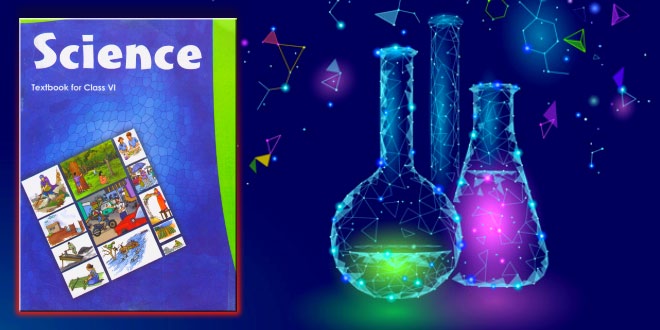Changes Around Us – 6th Class NCERT CBSE Science Chapter 06
Question: Breaking of tumbler and burning of paper are change in which we cannot get back the original substances what is the difference between these two changes?
Answer: Breaking of glass tumbler is physical change as no new substance has formed and the broken tumbler remains glass only. Burning of paper is change because after burning the paper is changed into ash a new substance has formed.
Changes Around Us – NCERT Question: What kind of change is cooking of food? Why?
Answer: Cooking of food is chemical change as after cooking the raw vegetables become cooked and cannot be converted back into raw vegetables. After cooking properties like softness, taste, colour change due to change in the molecules.
Question: Growth is increase in size. Is it a physical or chemical change? Give reasons?
Answer: Growth is a life process that take due to so many chemical changes that take place in the cells.
Question: Explain the difference between physical and chemical changes, give on example each.
Answer:
Physical change:
- Only the physical appearance changes.
- They are mostly reversible.
- Energy is may or may not be absorbed or released.
- They are temporary.
- For e.g.: melting of chocolate boiling.
Chemical change:
- A new substance is formed.
- They are mostly irreversible.
- Energy is either absorbed or released.
- They are permanent.
- For e.g.: Burning, cooking.
Question: One way changes are classified is reversible and irreversible Explain with examples.
Answer:
Reversible:
- A change that can be carried out in the reverse direction is known as reversible change.
- The internal structure of the substances involved do not change in reversible changes.
- They can easily be reversed.
- For e.g.:
(i) The shape of the balloon come back to it original size when we stop squeezing.
(ii) The molten wax becomes solid again when cooled.
Irreversible:
- A change that can be carried out in the reverse direction is known as irreversible change.
- The internal structure of the substances involved change in irreversible changes.
- They cannot be reversed easily.
- For e.g.:
(i) Bursting of a balloon cannot be reversed.
(ii) Cooking of food or burning of wax cannot be reversed.
Question: When a candle burns, both physical and chemical changes occur. Explain.
Answer: When a candle burns the wax is solid, wax. When solid wax is converted into liquid wax and the liquid wax is converted into wax vapour it is physical change. But when the wax vapour is converted into Carbon dioxide + water + energy (CO2 + H2O + energy)
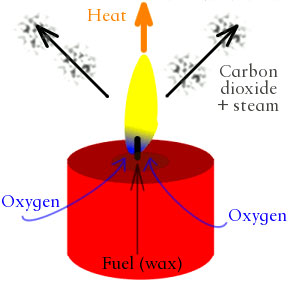
Changes Around Us – NCERT Question: What is a chemical reaction?
Answer: When the molecules of the substances change to from a new substance chemical reaction takes place. Before reaction they are known as reactants and after reaction they are known as products. For e.g. – vinegar reacts salt farm carbon dioxide, iron reacts with water to from rust.
Question: Give one example to that when substance are mixed, it may result in a chemical change or a physical change depending on their conditions.
Answer: It we mix iron and sulfur, no new substance has formed. They can be separated by a magnet and if we heat them new substance, Iron Sulphite is formed.
Question: Tearing of paper is irreversible. It is therefore a chemical change. Do you agree? Give reasons.
Answer: Yes tearing of paper is irreversible but not a chemical change as we cannot get the original paper back in its original for and a new substance is not formed.
Question: A potato remains a potato even after cooked. Therefore, Cooking is a physical change. Do you agree? give reasons.
Answer: No, it is not a physical change as when it is cooked changes take pace in molecules. Then the colour, softness, taste changes it is a chemical change.
Question: When sugar dissolves in water, it disappears. That means it must have change into a new substance. Therefore, dissolving is a chemical change. Do you agree?
Answer:
- Sugar remains sugar and water remains water.
- Properties are same and do not changed.
- They can be separated by crystallization.
Question: On boiling potato becomes soft and egg becomes hard. What value do you barn?
Answer: On boiling the potato becomes soft and egg becomes hard through both of them undergone through the same situation but they reacted differently. We barn that it’s the person’s character not the circumstances that determine that he will be successful or not.
Question: Give two examples of slow changes.
Answer:
- Growing of plants
- Ripening of fruits.
Question: Give two examples of fast changes.
Answer:
- Blowing of balloon
- Rolling out roti from dough ball.
Question: Give two examples of reversible changes.
Answer:
- Drying of wet clothes
- Heating of milk.
Changes Around Us – NCERT Question: Give two examples of irreversible changes.
Answer:
- Milk to cheese
- Cooking of food.
Question: Can you say deforestation is an irreversible or reversible change?
Answer: It is an irreversible change.
Question: Why does a blacksmith heat the metal rim to fix it on a cart wheel?
Answer: A blacksmith heats the metal rim to fix it onto a cart wheel because a metal rim is made slightly smaller. On heating, the rim expands and fits onto the wheel. Then on cooling, the rim contracts and fits tightly onto the wheel.
Question: What are slow and fast changes? Give examples.
Ans: The changes which take place in a long period of time are called slow changes whereas that changes which take place in a short period of time are called fast changes.
Question: What is a physical change? Explain with example.
Answer: The changes in which only physical properties of substances are changed and no new substance is formed is called physical change. It is a reversible change. Example: Boiling and freezing of water.
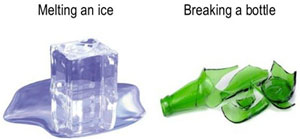
Question: What is a chemical change? Explain with example.
Answer: The changes in which new substance with new chemical properties are formed are called chemical changes.
Example: Reaction between washing soda and lemon juice in which C02 and other substances are formed.
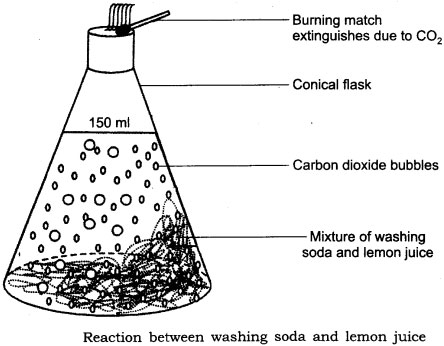
Changes Around Us – NCERT Question: What happens when sugar is heated?
Answer: When sugar is heated continuously then a black powdery substance is formed. This is a chemical change.
Question: Explain how a metal rim slightly smaller than a wooden wheel can be fixed on it.
Answer: The metal rim is always made slightly smaller than the wooden wheel. The metal rim is heated. On heating, the rim expands and fit onto the wheel. Cold water is then poured over the rim. Due to cooling the metal rim contracts and fits tightly onto the wheel.
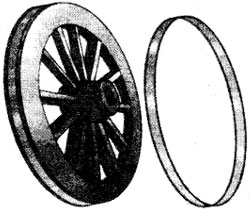
Question: How does curd being set? Is this change reversible?
Answer: A small quantity of curd is added to warm milk. The milk is stirred and is set aside undisturbed for a few hours at a warm place. In a few hours, the milk changes into curd.
Curd formed from milk cannot be changed into milk again. So, this an irreversible (cannot be reversed) change.
 Class Notes NCERT Solutions for CBSE Students
Class Notes NCERT Solutions for CBSE Students
